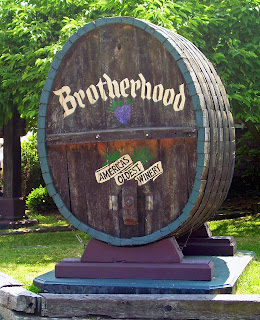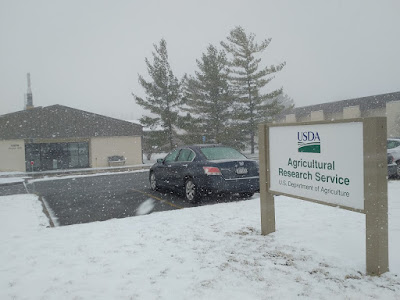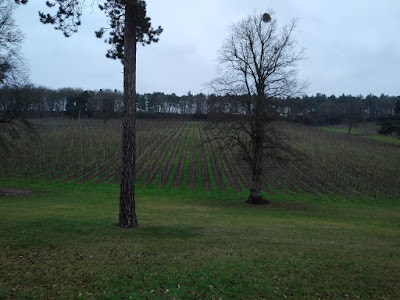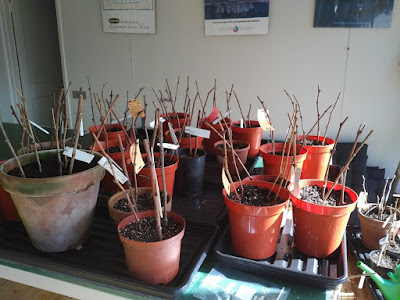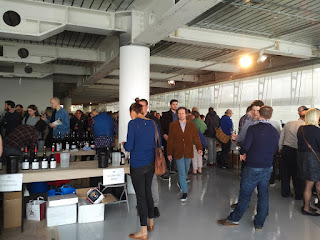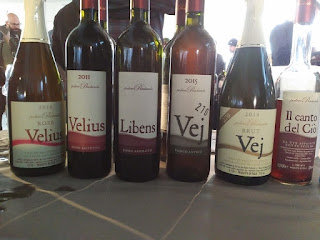In his valedictory post for the New York Wine and Grape Foundation, Jim Trezise writes;
Cornell University and Cornell Cooperative Extension have provided our winegrowing community with world-class research and communication that is second to none. We are incredibly lucky to have Cornell as a partner, and our industry colleagues from other states are incredibly jealous.
New York State ranks 3rd in the production of wine grapes in the US behind California (90% of the totel) and Washington State - 2nd if you include table grapes and grapes for the production of grape juice.
Historically, New York has not been an obvious place for grape cultivation. the Oxford Companion to Wins says 'After unsuccessful trials with Vinifera around Manhattan Island in the first days of settlement, nothing more is heard of viticulture in New York until the early 19th century.' Activity resumed in the first half of that century with American Labrusca varieties such as Niagara, and principally Concord, mainly for grape juice.
The Episcopalian preacher/Abolitionist/Teetotaller/Dentist Thomas Welch also found time to perfect pasteurisation of this grape juice. Welch's Grape Juice became famous around 1900. A company called Monarch decided in 1940 to make sacremental wine for the Jewish community and persuaded the Manishewitz company of New Jersey - makers of well known Matzos - to license their name for this purpose. Apparently, the grapes from upstate New York were of variable quality so sugar was added making the familiar sweet wines under this name. Manishewitz teamed up with Welch's in 2016 to make grape juice which was kosher for passover, still from the Concord grape.
Although New York boasts the oldest winery in continuous production in the US - the Brotherhood winery in the Hudson Valley (1839), wine continued to be made from Labrusca and hybrid varieties. Prohibition delayed any progress for decades. The after-shocks are still being felt with restrictions of shipping and sale of various sorts.
In the 1950s Dr. Konstantin Frank moved to Geneva from the USSR learning English and working for two years in a non-academic capacity at the Cornell University Experimental Station before going on to prove that Vinifera varieties could be grown successfully in New York State. The rest is history as they say, bringing 300 years of failure to grow Vinifera varieties to a close.
At the moment when Dr. Frank met up with the New York State Agricultural Experiment Station (NYSAES) at Geneva the work being carried out there could be said to have begun to converge with more research into Vinifera varieties.
Founded in 1880, the NYSAES has been researching the improvement of fruit varieties since 1887 and became part of Cornell University in 1923. With 80% of New York grapes going into grape juice, dessert grapes and grape products other than wine, it is not surprising that emphasis had been on helping farmers grow grapes for those purpuses and what is rather charmingly referred to as the 'Home Vineyard and Roadside Market.' As Cornell's website has it;
Cornell Scientists have introduced 279 new fruit varieties since 1880. By combining traditions methods with the latest molecular techniques such as marker-assisted selection, breeders are able to improve fruit quality, productivity, insect and disease resistance, tolerance to cold weather and the growth habits of trees and vines. Cornell varieties are widely grown in New York and around the world and have been well accepted by growers, processors and consumers.
A list of some older varieties bred at Geneva includes historical yet unfamiliar names such as
Alden (1952)
Bath (1952)
Buffalo (1938)
Fredonia (1927)
Golden Muscat (1927)
Ontario (1908)
Schuyler (1947)
Seneca (1930)
Sheridan (1921)
Steuben (1947)
Urbana (1912)
Van Buren (1935)
Yates (1937)
and seedless varieties such as Canadice, Glenora, Himrod, Interlaken, Lakemont, Suffolk Red and Romulus.
The Geneva Double Curtain grapevine training system is a most obvious advance (1960) to come out of the station for grape-growers and wine-lovers in general.
Its inventor, Nelson J. Shaulis also invented the mechanical harvester by the way.
Since the successful introduction of Vinifera varieties in New York State, the NYSAES has continued to help farmers by means of new cold and disease resistant hybrids some of which are getting known as alternatives to the classic varieties. Again the website;
Today, the Station serves an evolving agricultural sector that remains an economic engine for New York State, valued at over $4 billion a year. New programs have been added to keep pace with changes in New York agriculture, including programs to serve the state’s grape and wine industries, hop producers, bioenergy crop production, food entrepreneurs, and farmers facing new crop pests and diseases.
Of the new varieties, Traminette is a case in point having been develpoed partially from Gewurtztraminer and retaining some of Gewurtz's character. We bought an enjoyable 100% Traminette at Astor Wines in NYC and recently found an example by Fox Run at ProWein, Dusseldorf no less. The other more recent varieties bred at Geneva include
Cayuga White (1972)
Chardonel (1991)
Corot Noir (2006)
Glenora (1972)
Horizon (1982)
Marquis (1996)
Melody (1985)
Suffolk Red (1972)
Valvin Muscat (2006)
 |
| Bruce |
Insisting on first
name terms, Bruce received us royally and was patience itself in
describing the history and activities of his institute.
Going back over his predecessors he mentioned the names of John Einset and Bob Pool whose legacy he has built on.
Bruce has now developed Aromella which he describes as a daughter of Traminette. Aromella is more winter-hardy and productive and has already proved popular with growers.
 |
| Bob Pool, Bruce Reisch's immediate predecessor |
Going back over his predecessors he mentioned the names of John Einset and Bob Pool whose legacy he has built on.
 |
| Aromella |
Bruce has now developed Aromella which he describes as a daughter of Traminette. Aromella is more winter-hardy and productive and has already proved popular with growers.
| Arandell |
Another of Bruce’s
recent progeny is the blue grape Arandell – the first to come out
of Geneva’s ‘No Spray Program.’
Bruce comes from a
city background (NYC). His father was a keen amateur horticulturalist an
grew plants hydroponically in their apartment. This inspired Bruce
to enter his profession.
He explained that
another achievement of his team has been to develop means of
identifying genes in seedlings at a very early stage (4 – 6 weeks)
which speeds up the process of developing new varities no end.
Bruce and his colleagues are working on the many diseases that show up once Powdery and Downy Mildew are controlled. These include Anthracnose, Phomopsis, and Black Rot. Gradual and patient work in these fields is obviously crucial.
Bruce spoke about
the friendly relations and sometimes rivalry betweeh Geneva and other
research stations arund the world including some we have already
visited (Geisenheim, Geilweilerhof) and others we hadn’t heard
about (Colmar). He described how sometimes one station would make a
big discovery and then pull ahead of the others until someone else
made an advance. It sounds a fascinating world.
Anyone who follows
developments in wine will have noticed what extraordinary
improvements have taken place all over the world with unknown
varieties coming online and whole areas coming up to say nothing of
improvements in vinification. These advances are due to all sorts of
factors, an important one of which is undoubtedly the work carried
out by institutes such as this.
As well as grape breeding the faculty and graduate students from all over the world study and research the following fields;
Fruit soils
Nutrition for fruit crops
Vine physiology
Rootstocks,
Fruit pollination and crop set
Cytology of fruit plants
Virus transmission through pollen
Air pollution effects on grapes
Weed control
Disease epidemics and control
Insect pest control
Applications of genomics to fruit crop breeding
As well as grape breeding the faculty and graduate students from all over the world study and research the following fields;
Fruit soils
Nutrition for fruit crops
Vine physiology
Rootstocks,
Fruit pollination and crop set
Cytology of fruit plants
Virus transmission through pollen
Air pollution effects on grapes
Weed control
Disease epidemics and control
Insect pest control
Applications of genomics to fruit crop breeding
 | ||||
| Dr. Thomas Chao whose speciality is Malus (Pomology) |
Our visit coincided with an impressive snow storm. Impressive to us but probably nothing extraordinary to the locals as that part of the state is well known for having the most snow. Altough feeling what he called apropriately 'under the weather' Dr. Chao kindly answered our questions, gave advice and then most generously offered to show us some of the nearby orchards and vineyards containing the facility's collections.
 |
 |
| Wild vines |
and fascinatingly a vineyard given over to a collection of wild native vines, kept not for table or wine grapes but for their genetic properties.
 |
| Around Geneva is typical farming country |
 |
| In the distance, what looks like a dormant vineyard |

